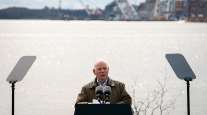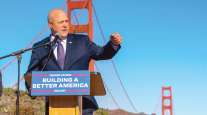Democrats Rip Trump's Infrastructure Plan as ‘Sleight of Hand’

President Donald Trump’s $1 trillion plan for improving the nation’s infrastructure isn’t enjoying the immediate bipartisan support he may have hoped for.
Democrats ripped Trump’s budget release on May 23, when he announced his plan to spend $200 billion over 10 years to spur at least $800 billion in state, local and private infrastructure investment. They said the federal spending would be offset by cuts to existing programs that already fund transportation projects.
“President Trump’s campaign promises on infrastructure are crumbling faster than our roads and bridges,” Senate Democratic Leader Chuck Schumer said in a statement. “The fuzzy math and sleight of hand can’t hide the fact that the president’s $200 billion plan is more than wiped out by other cuts to key infrastructure programs.”
Trump’s plan calls for chopping the Department of Transportation’s 2018 discretionary budget by $2.4 billion, or almost 13%. The proposal would eliminate $499 million for the popular TIGER program, which awards grants to states for transportation projects, and cut $928 million for transit work and $630 million for Amtrak.
The administration’s plan included proposals that won Democratic praise, such as expanding the Transportation Infrastructure Finance and Innovation Act federal loan program and lifting the cap on tax-exempt bonds for private investors. However, the plan was short on detail about how the $200 billion would be spent to encourage investment, infrastructure experts said.
Promise of Incentives
“What I see is sort of a promise of incentives without a lot of detail, and a number of specific cuts with detail,” said Sarah Kline, a fellow with the Bipartisan Policy Center, a Washington-based research group focused on infrastructure. “It’s hard to kind of look at that and say ‘OK, this is going to mean greater investment in infrastructure.’ ”
More details on the plan are forthcoming, U.S. Transportation Secretary Elaine Chao told reporters in a conference call May 23, adding that the administration expects to deliver a legislative package to Congress by the third quarter. She said the broad aim of the initiative, which includes a comprehensive overhaul of the regulatory review and approvals process to accelerate projects, is to make long-term changes for how U.S. infrastructure is regulated, funded, delivered and maintained.
“We do not want to displace the local and the state-level funding,” Chao said. “The federal government will do its fair share, but we also want to partner with the states and tribes and localities.”
Encouraging states and localities to help themselves sounds good, “but I think many states would hope that encouragement would include additional federal funding,” said Sean Slone, director of transportation and infrastructure policy for the nonpartisan Council of State Governments.
Broader Needs
Republican congressional leaders offered mostly noncommittal praise while also underscoring some of the challenges, such as how to meet the needs of rural areas where the inability to use tolling or fees makes it difficult to attract private investment.
“Clearly, he intends to prioritize infrastructure,” Republican Senator John Barrasso of Wyoming, chairman of the Environment and Public Works Committee, said in a statement. “I plan to work with the administration, and the members of the committee, to move an infrastructure bill which addresses the needs of rural America, as well as the broader needs of the country.”
Trump’s infrastructure initiative “recognizes important needs in our country and takes a long-term view on meeting those needs,” Republican Senator John Thune of South Dakota, chairman of the Senate Commerce, Science and Transportation Committee, said in a statement.
Democrats also highlighted Trump’s budget treatment of the Highway Trust Fund, which is funded primarily through gas and diesel taxes and sends money to states and localities for highway and transit projects. In recent years, the federal government has supplemented the fund to meet spending needs. Trump’s budget, however, assumes no spending above revenues after 2020 from the fund, a move that Democrats are calling a $96 billion cut by 2027.
Spending Dropoff
Chao said it’s not a cut but a “dropoff,” and the administration said the move is meant to spur Congress into solving a long-term funding problem.
“Trump’s budget would take existing money from cities and states that pays for roads, bridges and transit, and would give it to billionaires and corporate interests,” Caroline Behringer, a spokeswoman for House Democratic Leader Nancy Pelosi, said in a statement. “Democrats are willing to work with Republicans to make sorely needed repairs to America’s infrastructure, but we need a real, bipartisan plan, not tax cuts disguised as an infrastructure plan.”
Rep. Peter DeFazio of Oregon, the top Democrat on the House Transportation and Infrastructure Committee, said he welcomes proposals such as expanding the TIFIA loan program. It helps finance surface transportation projects through direct loans, loan guarantees and lines of credit. Increasing the TIFIA subsidy to $1 billion a year for a decade could leverage as much as $140 billion in credit assistance and about $424 billion in total investment, the administration said in a fact sheet.
Massive Investment
DeFazio also lauded the plan to raise the existing $15 billion cap on Private Activity Bonds issued on behalf of private entities to help finance public-private partnerships. But DeFazio said those elements won’t spur the kind of private investment necessary to get to $1 trillion or fix what the American Society of Civil Engineers has determined to be a D+ condition for U.S. infrastructure, he said.
“Those things are OK, they’re nice,” DeFazio said in a telephone interview. “But it’s not going to address the problem, and it’s not going to move us toward a massive investment that is long overdue.”
One of the more controversial elements of Trump’s outline was reducing the tolling restriction on interstate highways to attract private investment. Trump also supports allowing the private sector to construct, operate and maintain interstate rest areas, according to the plan.
The International Bridge, Tunnel and Turnpike Association hailed the idea as giving states the “maximum flexibility needed to make the best funding decisions for their local transportation projects.”
Robert Poole, director of transportation policy at the Reason Foundation, a free-market research group based in Los Angeles, cited an estimate that it would cost almost $1 trillion to reconstruct the entire aging interstate system over the next several decades. Pensions and infrastructure funds “would love a piece of that action,” Poole said.
But the Alliance for Toll-Free Interstates, which has more than 2,900 members, including trucking companies, chain restaurants and transportation firms, called tolls “the worst funding mechanism available.”
Bill Sullivan, executive vice president for advocacy at American Trucking Associations, agreed, saying, “in addition to being inefficient and unsafe, tolling has proven to be deeply unpopular.”
DeFazio also said there may be a political price for Trump and Republicans in the 2018 mid-term Congressional elections.
“That might seal the Democrats’ victory in ’18 because Trump country would be some of the hardest hit areas with tolling the interstates,” he said.




